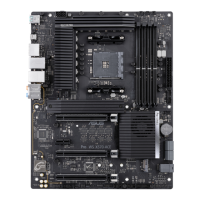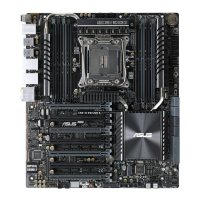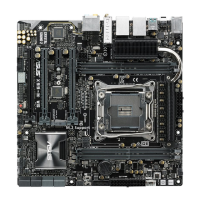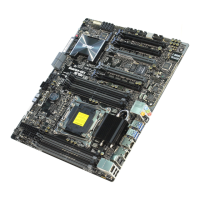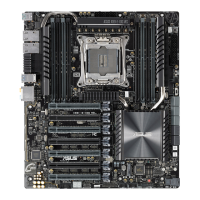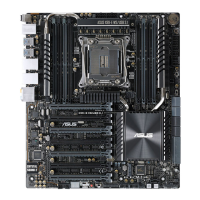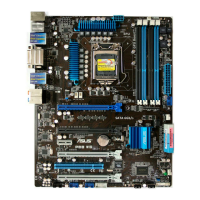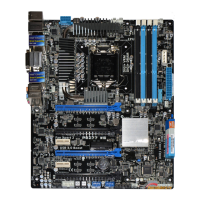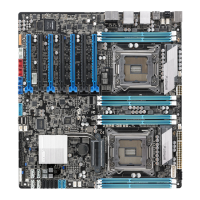Do you have a question about the Asus WS X299 PRO Series and is the answer not in the manual?
Precautions to prevent electrical hazards during system operation and maintenance.
Guidelines for safe handling and operation of the motherboard and its components.
Overview of the manual's structure and the content of each chapter.
Resources for additional product information and software updates.
Explanation of text formatting conventions used for menus, items, and keys.
Introduces motherboard features, connectors, switches, and jumpers.
Visual guide to the motherboard's components and connectors with labels.
Details about the LGA2066 socket and CPU installation precautions.
Information on DDR4 DIMM slots and memory configuration.
Details on available PCIe slots and their configurations for expansion cards.
Explains the function of onboard buttons like Power, Reset, MemOK!, Clear CMOS, and EZ XMP.
Configuration of jumpers for CPU Over Voltage, Thermal Sensing, VGA, IPMI, and BMC settings.
Explains the function of Q LEDs, EZ XMP LED, Location LED, and Q-Code LEDs.
Details on various internal connectors like SATA, USB, Front Panel Audio, and RGB headers.
Step-by-step guide for installing core PC components like CPU and motherboard.
Detailed steps for correctly installing the CPU into the LGA2066 socket.
Instructions for mounting the CPU cooler and fan, including thermal material application.
Steps for installing the motherboard into the PC chassis, including Q-Shield.
Procedure for installing and removing DDR4 memory modules (DIMMs).
Guide on connecting the motherboard power supply units (24-pin, 8-pin, 6-pin).
Instructions for connecting SATA storage devices like HDDs and SSDs.
Details on connecting front panel connectors for USB, Audio, and Q-Connector.
Steps for installing PCIe x16 and PCIe x4 expansion cards.
Guide on installing M.2 SSD modules into the M.2 slots.
Instructions for installing the ASUS fan holder and fan for additional cooling.
Overview of BIOS update methods, including USB BIOS Flashback.
Identifies and explains rear I/O ports and audio connections.
Diagrams illustrating how to connect headphones, microphones, and speakers.
Procedure for the initial power-on and system check (POST).
Instructions on how to properly shut down or put the system into sleep mode.
Introduction to UEFI BIOS and its importance for system settings.
How to enter BIOS setup at startup and after POST.
Overview of the BIOS EZ Mode interface and basic system information display.
Introduction to the Advanced Mode for detailed BIOS configuration options.
Explains BIOS menu bar, hotkeys, scroll bar, general help, and navigation elements.
How to manually configure fan speed profiles and operating modes.
Utility for automatic overclocking, system tuning, and RAID setup.
Personal space to save and access frequently used BIOS settings.
Overview of system information and basic settings like date, time, and security.
Options for configuring overclocking-related settings for CPU and DRAM.
Configuration options for CPU, system devices, and other advanced settings.
Displays system temperature, power status, and fan settings.
Options for configuring system boot order, CSM, and Secure Boot settings.
Utility options for special functions like BIOS updates and Secure Erase.
Options for loading defaults, saving changes, discarding changes, and exiting BIOS.
Displays server management status and allows settings changes.
Information and utilities for updating the motherboard's BIOS.
Overview of supported RAID levels (0, 1, 5, 10) and their definitions.
Guidelines for installing SATA and PCIe SSD storage devices for optimal performance.
Steps to access and configure Intel RST in the UEFI BIOS for RAID setup.
How to enable CPU RAID functions using Intel® VROC and RSTe.
Instructions for creating a RAID driver disk for Windows OS installation.
Information on installing and configuring AMD CrossFireX for multi-GPU setups.
Essential prerequisites for enabling AMD CrossFireX technology.
Steps to uninstall existing graphics card drivers before installing new ones.
Procedure for physically installing two compatible graphics cards into PCIEX16 slots.
Guidance on installing graphics card drivers that support AMD CrossFireX.
How to activate the CrossFireX feature via the AMD Vision Engine Control Center.
Visual representation of the motherboard's 44-lane configuration.
Visual representation of the motherboard's 28-lane configuration.
Visual representation of the motherboard's 16-lane configuration.
Visual representation of the motherboard's 44-lane configuration.
Visual representation of the motherboard's 28-lane configuration.
Visual representation of the motherboard's 16-lane configuration.
List of Q-Code error codes and their corresponding descriptions for troubleshooting.
Important compliance and warning information for the user.
Contact details for ASUS technical support and customer service.
| Chipset | Intel X299 |
|---|---|
| CPU Socket | LGA 2066 |
| Form Factor | ATX |
| Memory Slots | 8 |
| Memory Type | DDR4 |
| Maximum Memory | 128GB |
| USB Ports | 4 x USB 2.0 |
| Network | Intel I219-V Gigabit LAN |
| Audio | Realtek ALC S1220A 8-Channel High Definition Audio CODEC |
| PCIe Slots | 3 x PCIe 3.0/2.0 x16 (supports x16, x16/x16, x16/x16/x8) |
| Storage Interface | 2 x M.2, 8 x SATA 6Gb/s |



